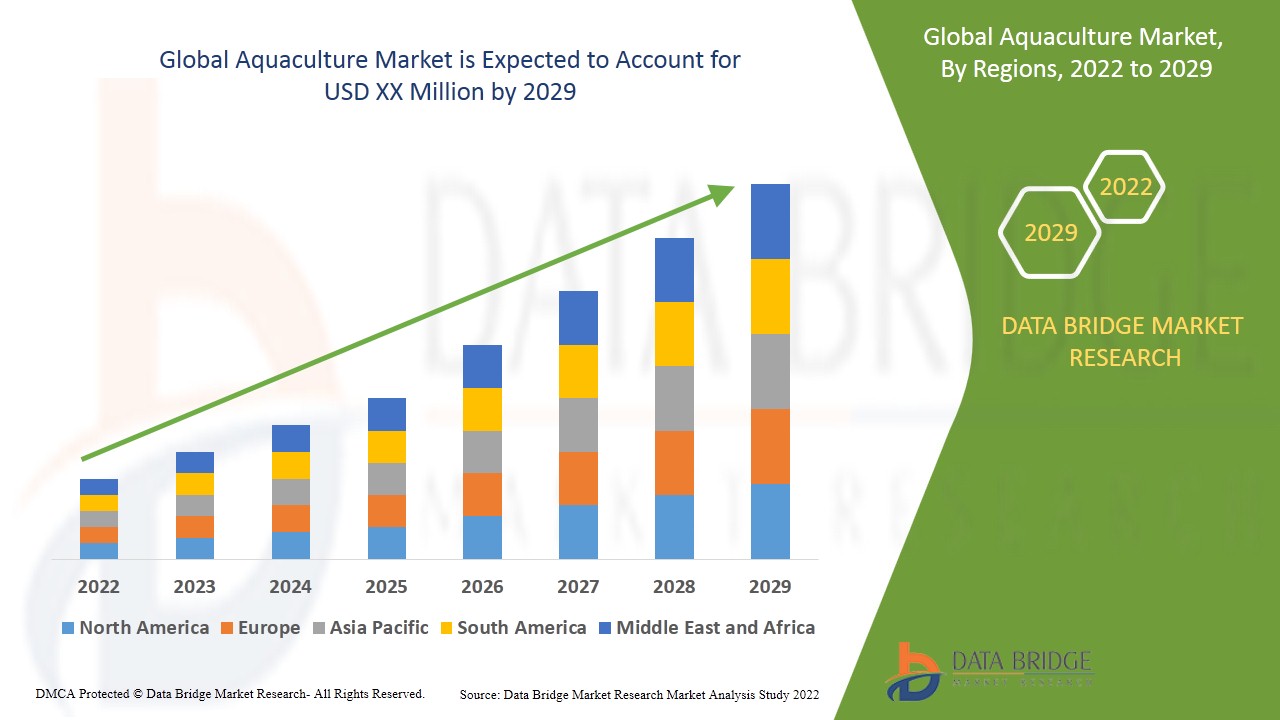Aquaculture Market Share, Growth Analysis & Forecast 2032

"Executive Summary Aquaculture Market Opportunities by Size and Share
The aquaculture market is expected to witness market growth at a rate of 7.8% in the forecast period of 2022 to 2029.
An international Aquaculture Market report lends a hand to identify how the market is going to perform in the forecast years by providing information about market definition, classifications, applications, and engagements. A complete discussion about numerous market related topics in this market research report is sure to aid the client in studying the market on competitive landscape. This market report spans different segments of the market analysis that today’s business demand. The data and information collected with the research is generally quite a huge and is also in a complex form. However, such intricate market insights are turned into simpler version with the help of proven tools and techniques to provide it to the end users.
As per the DBMR team predictions cited in the Aquaculture Market report, the market will grow with a specific CAGR value in the forecast period of 2023 to 2030. By taking into account strategic profiling of key players in the Aquaculture Market industry, comprehensively analyzing their core competencies, and their strategies such as new product launches, expansions, agreements, joint ventures, partnerships, and acquisitions, the report helps businesses improve their strategies to sell goods and services. The credible Aquaculture Market report contains market insights and analysis for Aquaculture Market industry which are backed up by SWOT analysis.
Analyze top trends and market forces impacting the Aquaculture Market. Full report ready for download:
https://www.databridgemarketresearch.com/reports/global-aquaculture-market
Current Scenario of the Aquaculture Market
Segments
- By Culture Environment: The aquaculture market can be segmented into marine water, fresh water, and brackish water based on the culture environment where the aquatic organisms are bred.
- By Species: This segment includes fish, crustaceans, mollusks, and other species that are cultivated for commercial purposes.
- By Production Type: Segmentation based on production type includes fish, mollusks, crustaceans, and others.
- By Fish Type: This segment comprises various fish types such as carps, salmon, trout, tilapia, and other species that are prominently farmed in the aquaculture industry.
- By Geography: The global aquaculture market can also be segmented into regions such as North America, Europe, Asia-Pacific, Latin America, and the Middle East & Africa to provide a comprehensive view of the market's regional landscape.
Market Players
- Cooke Aquaculture Inc.: A significant player in the market, Cooke Aquaculture is involved in the farming of Atlantic salmon, steelhead trout, and other species.
- Marine Harvest ASA: As one of the largest seafood companies, Marine Harvest focuses on salmon farming and processing, contributing significantly to the aquaculture market.
- Thai Union Group: Known for its global presence in seafood production, Thai Union Group engages in aquaculture activities for shrimp and other seafood products.
- Cargill, Incorporated: Cargill is a key player in the aquaculture market, providing a range of aquafeeds, nutrition solutions, and other services to support sustainable fish farming practices.
- Nireus Aquaculture S.A.: Specializing in the production of sea bream and sea bass, Nireus Aquaculture plays a vital role in the Mediterranean aquaculture industry.
The global aquaculture market is witnessing significant growth due to the rising demand for seafood products, driven by increasing health awareness among consumers and the need for alternative protein sources. Factors such as technological advancements in aquaculture practices, government support for the development of sustainable aquaculture, and the depletion of wild fish stocks are also contributing to market expansion. The shift towards intensive and controlled aquaculture systems, coupled with the adoption of advanced water treatment techniques and feed management practices, is further fueling the market's growth trajectory.
Aquaculture plays a crucial role in meeting the growing global seafood demand, especially as wild capture fisheries face challenges such as overfishing and environmental degradation. As a result, the aquaculture market is experiencing significant investments in research and development to enhance breeding techniques, disease management, and feed formulations to ensure the sustainability and efficiency of aquaculture operations. With a focus on improving productivity, reducing environmental impact, and meeting regulatory standards, market players are increasingly adopting innovative technologies and practices to drive growth and profitability in the aquaculture sector.
The global aquaculture market is poised for substantial growth in the coming years, driven by a combination of factors that are reshaping the industry landscape. One key trend that is expected to influence market dynamics is the increasing focus on sustainability and environmental responsibility within aquaculture operations. As consumers become more conscious of the environmental impact of food production, there is a growing demand for sustainably sourced seafood products. This trend is pushing aquaculture companies to adopt more eco-friendly practices, such as reducing the use of antibiotics, improving waste management systems, and enhancing water conservation efforts.
Moreover, technological advancements are playing a significant role in transforming the aquaculture sector. Innovations in areas such as automation, data analytics, and artificial intelligence are enabling aquaculture companies to optimize their operations, improve productivity, and reduce costs. For example, the use of IoT sensors in aquaculture farms allows for real-time monitoring of water quality parameters, feeding patterns, and fish health, leading to more efficient resource utilization and better decision-making.
Another important development in the aquaculture market is the rise of alternative feed ingredients. With concerns over the sustainability of traditional fish feed sources such as fishmeal and fish oil, there is a growing interest in exploring alternative sources of protein and nutrients for aquaculture diets. This includes the use of plant-based proteins, insect meal, single-cell proteins, and algae-derived supplements. By diversifying feed formulations and reducing reliance on wild-caught fish for feed production, aquaculture companies are not only improving the sustainability of their operations but also enhancing the nutritional profile of farmed seafood.
The regulatory landscape is also a crucial factor shaping the future of the aquaculture market. As governments worldwide implement stricter regulations to address issues such as antibiotic use, environmental pollution, and food safety in aquaculture, companies are required to comply with higher standards and certifications. This shift towards greater transparency and accountability is driving investments in traceability systems, certification programs, and quality assurance measures throughout the aquaculture supply chain.
In conclusion, the global aquaculture market is experiencing a phase of rapid evolution, driven by trends towards sustainability, technological innovation, ingredient diversification, and regulatory compliance. Market players that can adapt to these changing dynamics and embrace innovation are likely to thrive in the increasingly competitive aquaculture landscape. By staying attuned to consumer preferences, advancing sustainable practices, and leveraging cutting-edge technologies, aquaculture companies can position themselves for long-term success in a market that is poised for significant growth and transformation.The global aquaculture market is experiencing a paradigm shift driven by several key trends that are reshaping the industry landscape. One of the prominent trends influencing market dynamics is the increasing focus on sustainability and environmental responsibility within aquaculture operations. Consumers' growing awareness of the environmental impact of food production is leading to a rising demand for sustainably sourced seafood products. This shift is pushing aquaculture companies to adopt eco-friendly practices, such as reducing antibiotics usage, enhancing waste management systems, and improving water conservation efforts. Companies that prioritize sustainability and environmental responsibility are likely to gain a competitive edge in the market, as consumers increasingly seek ethically produced seafood products.
Technological advancements are playing a pivotal role in transforming the aquaculture sector. Innovations in automation, data analytics, and artificial intelligence are enabling companies to optimize their operations, boost productivity, and cut costs. Utilizing IoT sensors for real-time monitoring of water quality parameters, feeding schedules, and fish health allows for more efficient resource management and informed decision-making. By embracing technological innovations, aquaculture companies can improve operational efficiency, reduce environmental impact, and enhance overall sustainability, thereby positioning themselves for long-term success in the market.
Another significant development in the aquaculture market is the shift towards alternative feed ingredients. Concerns regarding the sustainability of traditional fish feed sources like fishmeal and fish oil have driven a surge in exploring alternative protein and nutrient sources for aquaculture diets. The adoption of plant-based proteins, insect meal, single-cell proteins, and algae-derived supplements is not only improving the sustainability of aquaculture operations but also enhancing the nutritional composition of farmed seafood products. By diversifying feed formulations and reducing reliance on wild-caught fish for feed production, aquaculture companies are aligning themselves with the growing consumer demand for sustainable and health-conscious seafood products.
The regulatory landscape is a crucial factor influencing the future trajectory of the aquaculture market. With governments worldwide implementing stricter regulations to address issues such as antibiotic use, environmental pollution, and food safety in aquaculture, companies are under pressure to comply with higher standards and certifications. This regulatory push towards greater transparency and accountability is propelling investments in traceability systems, certification programs, and quality assurance measures across the aquaculture supply chain. Companies that prioritize regulatory compliance and adhere to stringent standards are likely to enhance their brand reputation, build consumer trust, and gain a competitive advantage in the market.
In conclusion, the global aquaculture market is undergoing rapid transformation fueled by trends towards sustainability, technological innovation, feed diversification, and regulatory compliance. Companies that embrace these trends, adapt to changing consumer preferences, and leverage cutting-edge technologies are well-positioned to thrive in a highly competitive and evolving market landscape. By focusing on sustainability, technological advancements, ingredient diversification, and regulatory adherence, aquaculture companies can capitalize on the market's growth potential and drive long-term success in an industry poised for significant expansion and innovation.
Access segment-wise market share of the company
https://www.databridgemarketresearch.com/reports/global-aquaculture-market/companies
Targeted Question Batches for Aquaculture Market Exploration
- How is the Aquaculture Market performing in current economic terms?
- What’s the outlook for market growth over the forecast window?
- How is the market structured by segment?
- Which brands have the largest footprint in the Aquaculture Market ?
- What have been the most impactful recent product releases?
- Which regions and nations are assessed in the report?
- Where is the most dynamic market development occurring?
- Which country is predicted to lead the pack?
- What region holds a major stake in total revenue?
- What country has the most promising growth forecast?
Browse More Reports:
Global Construction and Demolition Waste Market
Global Cryptocurrency Banking Market
Global Cupuacu Butter Market
Global Digital Binoculars Market
Global Electrical Wiring Interconnect System (EWIS) Market
Global Electric Vehicle Thermal Management System Market
Global Epoxy Adhesive Market
Global Flavour and Fragrance Market
Global Food Vacuum Machine Market
Global Freeze-Dried Products Market
Global Hemp-based Foods Market
Global High Density Polyethylene (HDPE) Bottles Market
Global Household Refrigerator Market
Global Lymphedema Treatment Market
Global Maternal Health Market
Global Lyme Disease Drug Market
About Data Bridge Market Research:
An absolute way to forecast what the future holds is to comprehend the trend today!
Data Bridge Market Research set forth itself as an unconventional and neoteric market research and consulting firm with an unparalleled level of resilience and integrated approaches. We are determined to unearth the best market opportunities and foster efficient information for your business to thrive in the market. Data Bridge endeavors to provide appropriate solutions to the complex business challenges and initiates an effortless decision-making process. Data Bridge is an aftermath of sheer wisdom and experience which was formulated and framed in the year 2015 in Pune.
Contact Us:
Data Bridge Market Research
US: +1 614 591 3140
UK: +44 845 154 9652
APAC : +653 1251 975
Email:- corporatesales@databridgemarketresearch.com
"
- Art
- Causes
- Crafts
- Dance
- Drinks
- Film
- Fitness
- Food
- Παιχνίδια
- Gardening
- Health
- Κεντρική Σελίδα
- Literature
- Music
- Networking
- άλλο
- Party
- Religion
- Shopping
- Sports
- Theater
- Wellness


